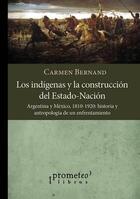In the Río de la Plata, as in Mexico, the construction of the nation-state on the basis of citizenship and the suppression of corporatism implied for the indigenous populations the loss of community lands, municipalities and autonomous territories. In both republics, the national process throughout the nineteenth century was arduous and slow, shaken by internal wars between political factions and by military interventions by foreign powers. The comparison focuses mainly on the struggles and demands of the indigenous peoples, on the international ramifications, and on the exaltation, by the new republics, of an idealized past. In the second part, dedicated to the indigenous problem, the political strategies of the main actors of the native peoples are analyzed, as well as the transformation of the colonial "Indian" and the sovereign "tribes" into peasants, laborers, proletarians or peo...read more
All book titles by this author
|
Title |
Price | ||
|---|---|---|---|
|
|
Los indígenas y la construcción del Estado-Nación, Argentina y México, 1810-1920 Author: Carmen Bernand Publisher: Prometeo |
$630.00
15%$535.50 |
Shopping cart
Loading cart
Important notices
|
|
Recordando a André Rouillé: Su legado en la fotografía André Rouillé 1948 - 2025 |
|
|
Libros de filosofía y co. Disponibles en Librería Herder |
|
|
Revista Filosofía & Co. nº 9 Nueva revista de filosofia divulgativa y actualidad |
|
|
"Espacios de la filosofía" - Mauricio Beuchot - Novedad Herder México |
|
|
Revista Filosofía & Co. nº 8 Nueva revista de filosofia divulgativa y actualidad |
Pay safely with:


In the webshop
New
|
|
Lo impensado 68035 $470.00 -0.00% $470.00 |
|
|
Arte y cosmotécnica 68201 $450.00 -0.00% $450.00 |
|
|
La seducción del encanto 69757 $650.00 -20.00% $520.00 |
|
|
Yo soy todo lo que no soy 69756 $550.00 -20.00% $440.00 |
|
|
Democracia y anarquía 69899 $825.00 -20.00% $660.00 |
In the press
Promotions
|
|
Psicología de grupos 20787 $800.00 -80.00% $160.00 |
|
|
El Instante eterno 20573 $520.00 -50.00% $260.00 |
|
|
Hacerlo Explícito 20472 $3,585.00 -50.00% $1,792.50 |
|
|
Hartos de corrupción 34956 $400.00 -50.00% $200.00 |
|
|
Filosofía de la edad antigua 20411 $605.00 -50.00% $302.50 |






